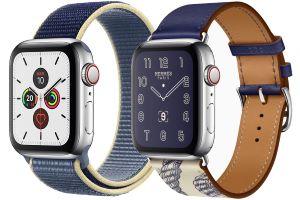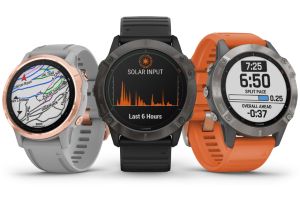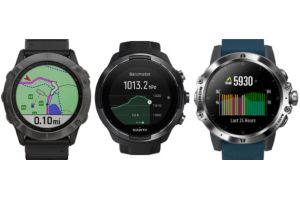After the Suunto 9, Suunto's high-end sports watch released in 2018, and the Suunto 5, an intermediate model released in 2019, the Finnish company is offering the Suunto 7, a watch that is both connected and sporty and has nothing in common with the previous models.
Its value is twofold: to offer, in a single model, a complete Smartwatch thanks to Wear OS, the operating system for watches from Google, and advanced sports functions benefiting from the full Suunto experience. This is a first in the world of GPS watches and the concept should attract the general public, including sportsmen and women.
Suunto 7 features
70 g
Dimensions
50 x 50 x 15.3 mm
Screen
Touch, AMOLED, color, 454 x 454 px, 1.4''
Autonomy
12 h / 48 h / 40 d
(GPS mode / Connected watch / Watch)
GPS
GPS, GLONASS, QZSS, Beidou, Galileo
True multi-sport
No
Recommended activities
Running, cycling, swimming, hiking (70 sports)
Connectivity
iPhone, Android. Wireless data transfer Bluetooth, Wi-Fi
Cardio-frequency meter
Yes, Optical wrist
Topographical maps
Yes
Music player
Yes (via App)
Yes (Google Pay)
Telephony / 4G
-
Barometric altimeter
Yes (automatic calibration and FusedAlti)
Barometer
Yes
Compass
Yes (via app)
Thermometer
-
Weather
Yes (via App)
Waterproof
5 ATM (50 m), usable for swimming and diving
Other
Wear OS (Google wizard, Google Fit, many downloadable apps, music, payment), 70 sports (but no multi-sport activities), activity tracking (Google Fit), maps, weather, built-in microphone, interchangeable wristbands, 8 Gb memory
Other models
Suunto 5 (mid-range), Suunto 9 (high-end)
Suunto 7 at a glance
The first Suunto watch to run under Wear OS
Suunto is innovating with this new dual-use watch, the brand's first to run under Wear OS (formerly Android Wear), Google's operating system for wearable devices such as watches. Wear OS is designed to manage small displays and provides access to many smart features such as Google Wizard, a payment solution, access to Internet services, weather functions, health monitoring (Google Fit) and much more.

This advance allows Suunto to offer a versatile watch that can incorporate almost any function simply by downloading it from the Google Play Store. The sports features and cards remain integrated in the Suunto Wear app, the brand's firmware.
The main functions offered
The Suunto 7 has a high-resolution AMOLED touch screen (454 x 454 px) with a 1.4" diameter. The technology (see below) is used on Smartphones and Smartwatches like the Apple 5 or the Garmin Venu. It includes a GPS compatible with most satellite systems (GPS, GLONASS, Beidu, QZSS, Galileo), an optical cardio on the wrist, a barometric altimeter, a compass (dedicated app). The watch offers 70 sports activities but not multi-sport (no triathlon profile for example). Its bracelets are interchangeable without tools. It offers a fairly low autonomy (12 hours in GPS mode and 48 hours maximum in connected watch), which makes it unsuitable for certain sports such as ultratrail.
Here is a brief outline of this model (we detail them later in this article):
- An AMOLED high resolution touch screen (454 x 454 px)
- An optical cardio on the wrist (possibility to connect a cardio belt)
- A GPS GPS, GLONASS, Galileo, QZSS, Beidu compatible
- 70 sports activities embedded but no multi-sports mode (triathlon, etc.)
- Wear OS and access to downloadable apps. New at Suunto, Wear OS gives access to many apps including the famous Google assistant (you can ask questions, access your calendar, ask for the weather, search for a hotel in the area, check flight schedules, and much more), a payment solution, downloadable apps.
- Offline mapping and heat maps (routes most used by the community) for 15 sports activities and accessible directly on the watch. The ability to program routes from a smartphone to send them to the watch.
- Wi-Fi for downloading maps, music and watch updates.
- Music: the watch has 8 GB of memory for storing music tracks and cartography. Listening is done directly from the watch via a pre-downloadable app and Bluetooth headphones. You can also listen to music from a smartphone controlled from the watch.
- Activity monitoring 24 hours a day via Google Fit
- FusedAlti, FusedSpeed and FusedTrack: Suunto's own functions combine data from multiple sensors (GPS, accelerometer, gyroscope, barometer) to improve the quality of altitude, speed and GPS track measurements.
Suunto 7 is not available as an LTE version (4G connectivity). It needs a Bluetooth connection to a smartphone or Wi-Fi network to access offline features such as Google Wizard, map downloads, etc. The watch can of course be used alone for sports activities, access to maps and listening to music.
Who is Suunto 7 for?
The Suunto 7 has the advantage of offering the best of the 2 types of GPS watches available today: sports watches and connected watches. Thanks to this, the Finnish brand, which was previously only popular with sportsmen and women, could now be popular with the general public. It will indeed be of interest:
- Athletes and competitors (all or almost all sports) interested in intelligent functions (payment, music, intelligent assistant, various services, etc.) in addition to the functions dedicated to sports.
- The general public is looking for a connected watch to wear every day that also offers advanced sports functions.
Detailed review of Suunto 7
We still only have a partial view of the new Suunto 7, as the model is not yet available for sale (except for pre-order). We will complete this article as soon as we have more information and the first tests can be carried out.
Design and technical specifications
The Suunto 7 comes in a reinforced polyamide case with a stainless steel bezel and scratch-resistant Corning Gorilla glass. It weighs 70 g, 4 g more than Suunto 5 Suunto 5 and 11 g less than Suunto 9 Suunto 9.

It is available in 3 colours: Black and Black Lime (black case and black and yellow strap), White Burgundy (white case and black and white strap) and Black (black case and black strap).
The Smartwatch is shock and dust resistant. Waterproof up to 50 meters (5 ATM), it can be used for diving. Suunto informs that the push buttons can be used underwater (which is not the case with all water-resistant watches).
We particularly appreciate the originality of the watchface installed by default, all in colour, which displays the attendance maps of the place where the watch is worn.
The wristbands are 24 mm wide and interchangeable without tools (a nail is enough).
On the electronic side, the Smartwatch incorporates Qualcomm's latest Snapdragon Wear 3100 chip, an energy-efficient processor designed specifically for watches. The Suunto 7 has 1 GB RAM and 8 GB storage capacity for data, maps and music. It offers Bluetooth 5.0 and Wi-Fi connectivity for data transfer.
| Features | Suunto 7 |
|---|---|
| Weight | 70 g |
| Case diameter | 50 mm |
| Thickness | 15.3 mm |
| Screen size | 1,4'' |
| Screen definition | 454 x 454 px |
| Crown | Stainless Steel |
| Glass | Corning Gorilla |
High resolution touch screen and AMOLED!
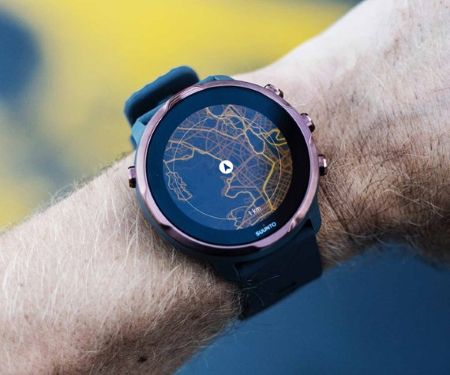
This model offers a high-resolution display (454 x 454 px) compared to the 320 x 300 px of the Suunto 9, the high-end and exclusively sporty model of the brand. It is touch-sensitive, making navigation and map use easier. However, the buttons can be used in parallel, which is very practical during the activity or if you wear gloves.
But the great novelty of this model, compared to other Suunto watches, is its AMOLED (Active-Matrix Organic Light-Emitting Diode) display, an alternative solution to LCD. Invented in the 1990s, the technology is now used in most smartphones and increasingly in large TV sets (the first AMOLED TV was launched by Sony in 2007). Instead of using liquid crystals that may or may not let through the light emitted by a backlight located behind the slab (LCD technique), it uses OLEDs, an improved version of the LED (light-emitting diode) and an active matrix (individual control of the LEDs). The colours are vibrant and their number is far greater than that of conventional watch screens. This allows Suunto to display high quality photos and animations.
Sensors: no compatibility with external sensors
This new Suunto has almost every sensor you can find on a high-end watch:
- GPS : compatible with GPS, GLONASS, Galileo, QZSS (the Japanese system) and Beidu (the Chinese system)
- Optical heart rate monitor: Suunto uses a Pixart sensor. Unlike Polar and Garmin, this one doesn't work (or doesn't work well) underwater. It also does not provide a pulse oximeter for measuring blood oxygen level and assessing altitude acclimatization. The watch can also be coupled with a cardio belt for greater data accuracy, especially for fractionated, or for measurements in the pool or at sea.
- Barometric altimeter and FusedAlti& trade; : the watch is equipped with a barometric altimeter, a sensor much more reliable than GPS for altitude, elevation and rate of ascent measurements. Suunto goes further by combining this data with GPS data (FusedAlti&trade algorithm) for increased accuracy and reliability under the most challenging conditions.
- Accelerometer and gyroscope: the accelerometer allows to evaluate the distances travelled when the GPS signal is weak or in a gym (treadmill, etc.). The gyroscope detects changes in direction. It is used in particular to refine the GPS track when the GPS signal is absent (FusedTrack & trade system;).
- Microphone: it allows you to query the Google wizard, get answers to any question, browse the internet, answer incoming SMS (Android only) and much more.

The watch is also equipped with an ambient light sensor for managing the brightness of the display.
As far as external sensors are concerned, this model is only compatible with a cardio belt. It will therefore not be possible to connect sensors for cycling or running (speed, cadence, power, footpod for example).
Autonomy
The Suunto 7 does not shine by its autonomy with only 2 days in connected watch mode (hardly better than Apple Watch) and 12 hours in GPS mode. It can provide up to 40 hours of battery life in watch mode. To do this, the energy-saving mode must be activated (this is also activated when the battery is low). All functions are then deactivated except for the time and battery status display.
As long as you listen to music while practicing, with the use of GPS, the autonomy falls to 8 hours. Suunto announces up to 18 hours of autonomy for versatile use (watch connected and a little sport), 30 hours for indoor training (without the GPS) or 5 hours for outdoor use. The use of cards adds a lot to the consumption: we fall to 7 am (instead of 12) if we display the cards at a rate of 10 seconds every 3 minutes.
That's not much compared to the 25 to 120 hours (Ultra mode) of Suunto 9 or the 20 to 40 hours of Suunto 5, especially since Suunto does not offer intelligent battery management on this model. It is therefore not suitable for long outings, such as ultratrail or ultramarathon.
It must be said that the AMOLED display consumes much more than a classic watch display (MIP for example). However, Suunto manages to limit the impact by turning off the display after 10 seconds of inactivity. At the hardware level, the Snapdragon Wear 3100 processor, the famous Smartwatch chip from Qualcomm, also helps to minimise power consumption.
Suunto announces that it takes 100 minutes to fully charge its sports connected watch and 20 minutes for a 2-hour workout.
| Usage | Suunto 7 |
|---|---|
| Watch mode | 40 days |
| Connected watch mode | 2 days |
| GPS training | 12 h |
| Outdoor use | 5 h |
Cartography, heat maps and navigation. Preloaded local maps.
The major interest of the Suunto 7, and which should appeal to sportsmen and women alike, is to offer, via the Suunto Wear App, on-board cartography and heat maps for 15 sports activities! You can get your bearings, see your route on the map, follow a route directly on the watch or take a popular route without the need for a Smartphone and the 4G network nearby.

Location maps are automatically downloaded as soon as the watch is connected to Wi-Fi or a connected smartphone. It is also possible to download a map of a given location other than the current position (e.g. for planned sports outings away from home). Depending on the region, the Suunto allows you to load 35 x 35 km or 50 x 50 km maps.
In addition to topographic maps, Suunto offers heat maps (or traffic maps) that can be accessed directly from the watch and are very easy to read thanks to the comfortable display (size, resolution and number of colours). The data are directly integrated into the topographic maps and therefore loaded with them. The heat maps show the routes most used by the Suunto community. This feature is found at Garmin. You can do sports anywhere, even without a planned route, and follow the route frequented by other sportsmen and women directly on watch. Suunto offers 15 sports activities! These include running, trail running, cycling and mountain biking, hiking, swimming, surfing, paddling, downhill and cross-country skiing, golf...
For navigation, the watch displays the route taken ("Thumbnail" track) and shows it on the map if the map is present. It is also possible to preload a route to be followed or to follow a route from the heat maps. Please note, however, that Suunto 7 does not offer turn-by-turn navigation or direction guidance. It is therefore important to check that you are following the trail by zooming the map and orienting yourself according to the display and contour lines. There is also no TrackBack function. You will have to retrace your steps following the trail and zoom in if necessary.
Music on your wrist thanks to Wear OS

Suunto was lagging behind its competitor Garmin in terms of the intelligent functions of its watches, especially for music. Many sportsmen and women like to play sports with music without having to bother with a smartphone. With the new Suunto 7, it's possible! Music is now accessible on the wrist!
But the difference with Garmin is that it doesn't have any mp3 player... Wear OS takes care of everything. Just download a dedicated app from the Google Play Store. Of course, you'll need to download the music tracks from a computer or Smartphone (the watch can store several thousand of them!) and have a headset or bluetooth earpieces for listening. You can also listen to your music from a smartphone controlled by the watch.
Google Pay: to pay for purchases with a flick of the wrist
The Suunto 7 incorporates an NFC chip which, combined with a Google Pay account, allows you to pay for your purchases directly from the watch, even without a smartphone. A practical aspect to do light sport without the risk of losing your wallet! For enhanced security, the connected watch does not directly transmit the credit card number but an encrypted virtual account number.
Sport functions and physiological measurements
In addition to the smart features provided by Wear OS and the integrated mapping in the Suunto Wear App, Suunto 7 offers the full Suunto sports watch experience:
- 70 integrated sports, each with a dedicated profile (2 to 4 displays with sport-specific data). On the other hand, the watch is not adapted to multi-sport (activities that follow on from each other). For triathlon, for example, it is therefore better to go for a watch designed for this sport (see our selection of the best current watches for triathlon).
- Recording of output data: distance (GPS or cadence-based if GPS is not used or the signal is weak), GPS track, heart rate (including during swimming), air pressure, altitude, height, vertical speed, cumulative ascents and descents, etc. The watch also displays graphs over the last few hours (altitude profile, heart rate, air pressure).
- Recovery time (rest time needed before resuming sports activities)
- PTE (Peak Training Effect) or Training Effect. This indicator provides information on the impact of the output on performance on a scale of 1 to 5. A score of 1 to 2 indicates that the training improved basic endurance and strengthened the basics. A score of 3 to 4 indicates an impact on aerobic capacity. A score of 5 indicates intense training.
- Training target areas with colour gauge indicating the level of effort on a scale of 5 (easy, moderate, difficult, very difficult, maximum)
- A compass to find your way and orient paper maps (app running under Wear OS)
- Activity tracking: it is provided by Google Fit. The function tracks the number of steps, calories expended, heart rate and, more recently, sleep monitoring. Points are awarded according to the efforts made. You can set daily goals to be achieved with alerts and receive invitations to move. Google Fit also offers breathing exercises to relax.
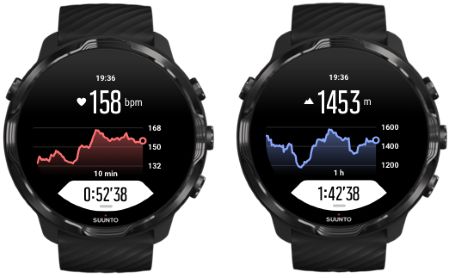

On the other hand, there are almost no running dynamics for the runners (ground contact time, vertical oscillation, etc.). Garmin also does not seem to have integrated on this model the Firstbeat algorithms used to provide the physiological data such as the evaluation of the stress level, the VO2max or the Body Resource proposed on the Suunto 5. Adaptive custom drives are not available either (present on Suunto 5).
The watch offers functions dedicated to the most common sports:
- Running: recording of pace, cadence, average and maximum lap time. But no full stroke dynamics (vertical oscillation, ground contact time, etc.).
- Bicycle: heart rate and average speed
- Swimming: swimming rhythm, heart rate (with belt), swimming time per length (in the pool), number of movements, swimming efficiency (SWOLF), auto intervals (with belt), swimming time per length (in the pool), number of movements, swimming efficiency (SWOLF), swimming time per length (in the pool), number of movements, swimming efficiency (SWOLF).
- Hiking: the watch displays altitude, elevation, vertical speed data thanks to FusedAlti (combination of barometric altimeter and GPS data).
The other functions: Wear OS and multiple possibilities
Suunto 7 offers many features unique to Wear OS, including :

- The Google assistant that allows you to ask a question, query your calendar, search for information on the Internet, etc.
- Google Fit for activity monitoring
- Google Pay to pay for purchases with your watch
- A compass
- Weather functions: daily weather, sunset and sunrise times, sea level pressure, thunderstorm warnings, local temperature, altitude graph, etc.
Thanks to Wear OS, the user will be able to download numerous apps to complement those already offered by the watch.
Smartphone notifications (emails, calls, SMS) are also present. SMS messages can be answered directly from the watch by choosing a predefined message or by using the microphone and voice recognition (with an Android smartphone only).
Finally, this model allows to share its results on the main applications such as Strava, Endomondo or TrainingPeaks.
Our opinion on the Suunto 7: should you buy it?
What is the Suunto 7 worth and should I buy it? Is it better to choose Suunto 9 if you're into sports or the cheaper Suunto 5? Is it comparable to the Fenix 6 Pro? Does it offer sports features that are up to the challenge for experienced athletes? So many questions that it is legitimate to ask oneself before making a choice.

A watch for everyone, including sportsmen and women
A mix of Garmin (sports features) and Apple (connected features), Suunto 7 is designed to be versatile and complete. First of all, it offers the best of today's connected watches with an infinite number of possibilities and possible evolutions since it runs under Wear OS. Simply choose and download an app to add features, knowing that new apps are regularly developed! This makes it more durable than most current GPS watches.
On the other hand, it offers Suunto's full experience in terms of sports functions. This is not the case with most so-called intelligent connected watches. Experienced athletes are unlikely to choose the Apple Watch or the Garmin Venu to go hiking or running a marathon.
This model is therefore not limited to everyday life. It should also be of interest to sportsmen and women.
Finally, the presence of cartography and attendance maps available offline makes it very interesting for activities such as hiking, trail, running, cycling or skiing off known trails but also travel. There are still few sports watches that offer cartography today. It can be found at Garmin (Forerunner 945, Fenix 6) and Casio. Coros will probably come there see the Coros watch series here. However, GPS navigation is not equal to that of Suunto 5 and Suunto 9 (see below).
Features: still a long way to go for sports and navigation
In terms of intelligent functions, it's hard to top that since Wear OS opens the door to every imaginable function for a connected watch. That said, Suunto 7 is still limited by its sensors. For example, it is not equipped with a pulse oximeter as at Garmin and Coros, nor an ECG as at Apple. Therefore, the measurement of blood oxygen level, the assessment of altitude acclimatization or the ECG will not be useful. The watch also does not offer assistance in case of a fall.

In terms of sports functions, it is very well equipped with its complete sensors (barometric altimeter, barometer, compass, GPS in particular) and 70 on-board sports. It has all the useful functions that Suunto has got us used to (display of altitude, altitude difference, vertical speed, recording of the route and heart rate, speed and distance data, thumbprint, etc.). ). The algorithms proposed by Suunto (FusedAlti, FusedTrack and FusedSpeed) improve measurement reliability. We benefit from all Suunto's experience.
However, like the brand's other watches, it still does not offer advanced racing dynamics. The newest Suunto 5 offers adaptive custom workouts. This one doesn't seem to offer it. No external sensors can be connected, except for a cardio belt (no footpod, no power, speed or cadence sensor!). It is also not suitable for triathlon.
Another regrettable point is that GPS navigation is limited, unlike other Suunto watches in this range. You can see the GPS track on the map, locate paths, assess the difficulty with contour lines, follow a given route, all offline, which is already considerable, but you won't find Trackback (retrace your steps), turn-by-turn guidance like with Garmin, or direction arrows like on Suunto 5 and Suunto 9, so you'll have to zoom the map to follow a track properly. Of course, it is also not possible to search for points of interest around you (hostel, restaurant, etc.).
Autonomy: to be reviewed
The battery life is not the strong point of this watch either, although it is still quite correct for a watch connected to the AMOLED display. It is not suitable for long outings (ultra-trail, ultra-marathon, long hikes, etc.). When the watch is connected, it should be recharged every 2 days unless it is used in pure watch mode.

Should I buy the Suunto 7 if I have a Suunto 5 or Suunto 9?
For Suunto 5 owners, the Suunto 7 may be a good alternative for many sportsmen and women who want a watch to wear every day and with intelligent functions. Provided you don't need GPS navigation, adaptive training, triathlon mode, and long battery life (20 to 40 hours in GPS mode on Suunto 5 with intelligent battery management). The Suunto 7 also does not provide the developments of the Suunto 5: stress assessment, Body Resource (available body energy) and VO2max. This ultimately constitutes a number of limitations.
The Suunto 7's display is much better, however, and you can listen to music while playing sports, pay for purchases from the wrist, or enjoy all the smart features available. For people looking for a versatile model (sport and everyday life), it can be a good alternative.
If you already have a Suunto 9, the top-of-the-line watch in the series, it all depends on the intended use. For triathlons, long hikes or trail rides, go your own way or buy the Suunto 7 as a supplement but not as a replacement. The Suunto 9 (like the Coros series) is the best in terms of range and offers intelligent battery management. The Suunto 7 is not multi-sport, has a low range, offers fewer physiological measurements and does not offer as complete GPS navigation. The 2 models are therefore not comparable.
A comparison between Suunto 3, Suunto 5, Suunto 7 and Suunto 9 will be available soon. Subscribe to our newsletter or follow us on Facebook to be informed of its publication.
Sunto 7 versus Garmin Fenix 6 Pro
Garmin is hard to match, so complete are his sporting duties. The Garmin Fenix 6 Pro offers all the useful sports sensors and functions, including full race dynamics, Training Effect, training programming, tips based on past workouts, and more. Read our detailed review of the Garmin Fenix 6.
The Fenix 6 Pro offers connected features but is not based on Wear OS. Therefore, no apps can be loaded and the available Garmin apps are limited. It has a real mp3 player, a payment solution, complete on-board cartography (roads, bicycle paths in the country or continent of purchase), a search engine for popular routes, a route generator and the possibility of searching for points of interest around you (hotel, restaurant, etc.).
GPS navigation is ultra-complete (route tracking with voice guidance, turn-by-turn guidance, back to the start). You can also follow a group of sports friends wearing the watch or be tracked on the Internet. It offers a fall detection function and assistance in the event of an incident.
In short, the Fenix 6 Pro is very complete but limited in terms of evolution and downloadable apps.
A comparison between the Suunto 7 and the Fenix 6 Pro will be available soon. Subscribe to our newsletter or follow us on Facebook to be informed of its publication.
Verdict
The Suunto 7 is a good connected and sporty watch with full functions, measurements that are supposed to be reliable (tests still need to be done to confirm this) and the best of today's connected functions. It's similar to an Apple Watch but with advanced sports features and does not require a smartphone to use it.
However, it has yet to mature to appeal to experienced athletes and competitors. The GPS navigation functions are not equal to those of Suunto 5 or Suunto 9, compatibility with external sensors (power, cadence, speed, footpod) is lacking, adaptive training and a number of physiological measurements (VO2max, body resource, stress) are missing, the triathlon mode is not offered, and the range greatly limits the possibilities for sports outings.
We recommend it for all occasional to regular sportsmen and women who are looking for a mixed model that offers both advanced sports functions and intelligent functions in a watch to be worn on a daily basis.
- Versatile, connected and sporty complete watch
- Offline mapping (on-board)
- Excellent display (AMOLED, touch, colour, high definition)
- Music on your wrist
- Google Pay payment function
- Heat cards for 15 activities
- Wear OS: Google assistant, many downloadable apps
- No triathlon mode
- Low autonomy
- Limited GPS navigation
- Firstbeat physiological measurements not proposed (VO2max, Body resource, stress)
- No possibility to connect external sensors (cadence, speed, power, footpod)
- No race dynamics and no race time predictor
Suunto 7 price and availability
The Suunto 7 is available for pre-order in some stores, including the Lepape store, and on the Suunto website. It will be delivered from 31 January. It is offered at 479 €.
These articles may also interest you
Garmin Venu : une montre connectée avec écran AMOLED et suivi complet de la santé
Apple Watch 5 : un écran allumé en permanence
Garmin Fenix 6 vs Suunto 9 Baro vs Coros Vertix compared: differences, which one to choose?
Polar Ignite : la montre multisports qui remplace votre coach
Meilleures montres cardio GPS 2025 pour la course à pied
Photo credit : Fotolia.com. This article contains commercial links.




